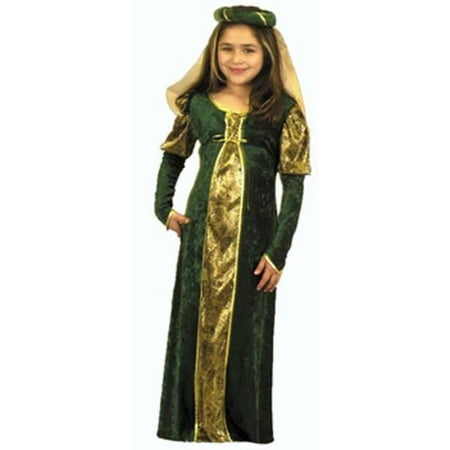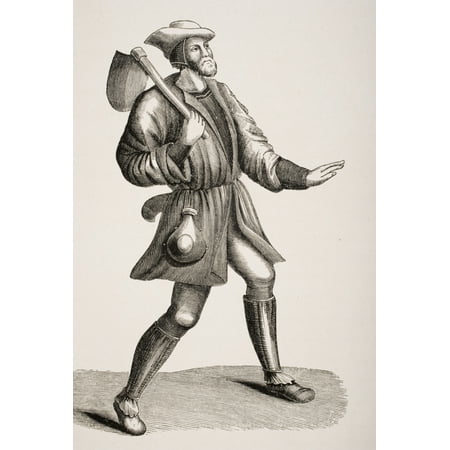Museum Replicas Renaissance Costume - Fair Maiden's Dress (GREEN) L/XL
Bestseller #1 16th Century Peasant Costumes
Information
The Fair Maiden's Dress; a perfect dress for the faire or going off to market. This colorful, 16th century styled dress features coordinating front trim and re-enforced boning in the front bodice for extra strong tight lacing. We have paired this piece with the Celtic Chemise (sold separately), however it will look lovely with any of our other chemises. Poly/cotton blend. Dry clean only.
The Well Dress'd Peasant: 16th Century Flemish Workingwomen's Dress
Bestseller #2 16th Century Peasant Costumes
Information
An in depth study of 16th Century Flemish working women's garments as depicted in the genre paintings of Pieter Aertsen and Joachim Beuckelaer gave author and award winning costumer Drea Leed plenty to go on for her recreation of the kirtles, petticoat bodies and partlets described in this book. Drawing on her years of experience, and the research of other costume historians, including the eminent Janet Arnold, Drea describes the painted garments as she sees them, and provides patterns and guidance for their reconstruction. Novice costumers will appreciate the simplified smock construction techniques and the helpful comments offered throughout the book. Experienced costumers will recognize some of the references quoted, but will quickly add the long list of new sources to their own research efforts.
12th Through 16th Century Peasant Man Pattern
Bestseller #3 16th Century Peasant Costumes
Information
RC004 - 12th Through 16th Century Peasant Man Pattern. Fits chests 34"-54". All Sizes in one envelope. Do you shun the nobility? Want to live a simpler life? Are you buying the lie that common people wore the same thing as the nobles but in lesser fabrics? Based on Reconstructing History's research, peasants (that is, common farmers and shepherds) were wearing almost the same clothing from the 14th through 16th centuries. From manuscript illuminations, books of hours, and the sketchbooks of famous painters like Holbein and Dürer comes evidence that peasants wore the same style of functional, easy-wearing clothing for the better part of three centuries. This is a pattern for Western European Peasant Men. It includes patterns for the tunic, leggings, hood or coif, drawers, and shirt shown in these illustrations and based on extant archeological examples. Great for Renaissance, Dark Ages, Tudor, Middle Ages, Medieval impressions. Suggested Fabrics: wool for tunic, hood and leggings linen for shirt, coif and drawers Yardage Requirements: tunic -- 3 yds at least 60" wide shirt -- 2 yds at least 60" wide drawers -- 2 yds at least 60" wide leggings -- 2 yds at least 60" wide hood ... [Read More]
The Dominance of Spain : 1550-1660 (Costume of the Western World)
Bestseller #4 16th Century Peasant Costumes
Information
24p cloth with white/blue dustjacket, from a Cambridge college library, minor shelfwear, binding firm, many b&w illustrations, very good condition
European Occupational Dress from the Fourteenth to the Eighteenth Century (The Library of Polish Ethnography, Vol. 49)
Bestseller #5 16th Century Peasant Costumes
Information
Published in a limited academic edition of 500 copies. Contents: Chapter I. Occupational or Everyday Dress?: 1 The Complexity of the Subject Matter 2 Fashion in Working Dress 3 The Source Base; Chapter II. Everyday Peasant Dress: 1 Peasant Clothes in Europe from the Late Middle Ages to the Early 16th Century 2 Peasant Working Clothes in Western and Southern Europe from the 16th to the Early 19th Century 3 Peasant Working Dress in the Countries of Central and Eastern Europe Which Had Distinct National Costumes in the 16th-18th Centuries 4 Peasant Working Dress in the Balkans, the Ottoman Empire and the Caucasus; Chapter III. Working Clothes in Crafts and Trade: 1 Occupational Divisions 2 Superior Crafts 3 Protective Garments in the Professions Requiring Special Hygiene 4 Professions Dangerous to Health 5 Professions Requiring a Minimum of Protective Garments 6 Merchants and Pedlars; Chapter IV. Dangerous Professions: 1 Body-Protecting Clothes 2 Mining and Metallurgy 3 The Building Trade 4 Land and Water Transport 5 Fishing and Hunting; Chapter V. The Professional Clothes of the Intelligentsia: 1 Intellectual Workers 2 Scholars, Lecturers and Students 3 Medical Professions 4 Lawyers;... [Read More]
Tudor Flat Cap (23", Forest Green)
Bestseller #6 16th Century Peasant Costumes
Information
The traditional "flat cap" is late 15th-, early 16th-century English. It was worn by both men and women. Lined. Reinforced brim
Medieval or Renaissance Corset or Bodice Pattern
Bestseller #7 16th Century Peasant Costumes
Information
2 shoulder options. Front or back tie options. This fun and fashionable pattern is representative of the late 16th century and early 17th century garments worn by upper class women in the royal courts and peasant women in their daily lives. Square-neck corset laces in back with purchased or handmade eyelets (instructions inside pattern). Scoop-neck corset fastens in front with purchased hook-and-eye tape, and features a peplum that echoes the waistline tabs of 16th-century doublets and corsets. Both versions feature the Elizabethan-era dropped center front waist. Make the scoop-neck version one or two sizes larger and wear as a vest. Pattern includes historical notes and a resource list for corset-making supplies. Suggested fabrics: For outer layer, medium to heavy-weight stable fabrics that do not drape, such as silk satin, brocade, damask, shantung, dupioni; cotton damask, brocade; linens and blends. For lining, same as outer layer or slightly lighter-weight equivalent.
16th Century Germany-Merchants & Peasants -1880 History of Costumes Litho #1212
16th Century Peasant Costumes
Benefits
1880 Braun Costume Print 16th Century Germany Dress Councilman Merchant Peasant
16th Century Peasant Costumes
Benefits
VINTAGE FASHION COSTUME PRINT ~ PEASANTS & SOLDIERS 16th CENTURY FRANCE
16th Century Peasant Costumes
Benefits
Toddler 16th Century Princess Costume~Toddler 16th Century Princess Costume
16th Century Peasant Costumes
Benefits
Child's 16th Century Princess Costume
16th Century Peasant Costumes
Benefits
16th Century Princess child size halloween costume available in child sizes. Our Kid's 16th Century Princess costume features a panne and pleated lame gown with matching headpiece.Panne and pleated lame gownMatching headpeiceSKU:
Costume Of A Peasant From A 15Th Century Miniature PosterPrint
16th Century Peasant Costumes
Benefits
Costume Of A Peasant From A 15Th Century Miniature was reproduced on Premium Heavy Stock Paper which captures all of the vivid colors and details of the original.Brand New and Packaged carefully in a oversized protective tube. This item Ships Rolled to insure maximum protection.Print Title: Costume Of A Peasant From A 15Th Century MiniatureProduct Type: Photo PrintArtist: Ken Welsh / Design
Watch 16th Century Peasant Costumes Video Review
Dressing an Elizabethan Peasant









